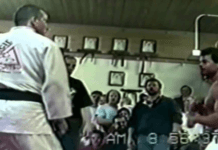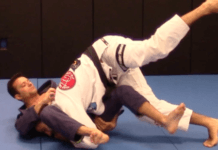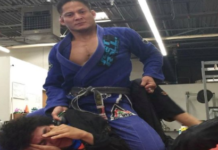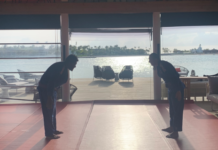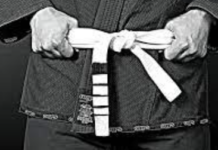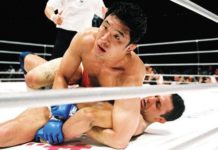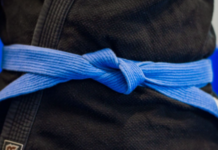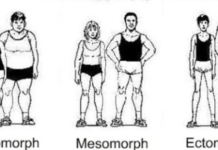Table of Contents
Brazilian Jiu-Jitsu and Judo are some of the most popular martial arts in existence. There are hundreds of thousands of practitioners of these martial arts all around the world. However, if you’re new to martial arts, Judo and BJJ may look quite similar to you. In both of these disciplines, there is a mat, the practitioners wear gis, there is some action in the standing position and on the ground. With all of that, to the novice eye, these two may seem alike. And this is not that far from the truth, to begin with. Actually, there are many similarities between BJJ and Judo.
However, upon closer inspection, you can also see significant differences between them. They are both grappling arts but with a very different proportion of the use of standing position and ground actions. The most significant difference is that Judo is more focused on throwing techniques with just a little groundwork. And BJJ focuses almost solely on groundwork with just a bit of throwing techniques and takedowns. However, this is not the only thing that distinguishes these 2 disciplines. Read on and learn more about both BJJ and Judo.
BJJ in a nutshell
BJJ is a Brazilian martial art derived from ju-jitsu, wrestling, and Judo. It is distinguished by its emphasis on ground combat.
History
In 1914, Maeda Mitsuyo, a 5th dan judo holder who had previously competed in professional wrestling tournaments in the United States, Great Britain, Spain, Cuba, Panama, and Mexico, settled in Brazil. Around 1919, Maeda was teaching 17-year-old Brazilian Carlos Gracie a mixture of Kōdōkan judo and American catch-as-catch-can combat. Maeda referred to the art he taught as “jiu-jitsu” and that term was used in the name of the newly formed style.
In 1924, Gracie opened a commercial martial arts academy. His students included, among others, his younger brother Hélio. Hélio’s sons Royce, Rorion, and Rickson continued their father’s work and developed the world-famous Gracie Jiu-Jitsu in the 1990s. Meanwhile, Carlos Gracie’s nephews introduced a related style called Machado Jiu-Jitsu to the United States at the same time. Collectively, the discipline has come to be known as Brazilian Jiu Jitsu.
Characteristics of the discipline
The fight in Brazilian Jiu Jitsu takes place mainly on the ground. The tactic is to bring the opponent to the ground, immobilize him and perform a finishing technique – leverage or choke. BJJ is all about grips. This discipline is dominated by levers, choking, and other techniques of immobilizing the opponent. Throws aimed at bringing the opponent to the ground are also used. While strikes are forbidden. Grips on the ground are often performed with legs by hooking or grabbing a part of the opponent’s body. One of the elements characteristic of Brazilian Jiu Jitsu is the so-called guard. A guard consists of putting the legs of a standing or kneeling opponent by a lying competitor. There is also a so-called mount, which consists in sitting astride a downed opponent.
In BJJ, there is a white, blue, purple, brown, and black belt. Some schools place, also an auxiliary division in the form of stripes on the belts. Belt color changes usually occur within 2-3 years. This means that it can often take over 10 years to achieve a black belt. There are no exams in BJJ, however. Giving subsequent belts is completely discretionary and depends only on the opinion of the coach
Popularity
BJJ owes its popularity today to several factors. First of all, the effectiveness of BJJ fighters in MMA fights played an important role (hence it began to be one of the basic elements of cross-training also for MMA fighters not originating from BJJ). Moreover, Brazilian Jiu Jitsu does not cultivate an Eastern tradition or ceremonial, thus attracting people who are not interested in them. BJJ techniques also create the illusion of being simple, which can sometimes encourage people to start training.
Judo in the nutshell
Judo is a martial art that has its roots in jūjutsu (a traditional Japanese martial art or a method of hand-to-hand combat, unarmed or with the use of small weapons, used in attack and defense). It was developed in Japan as a sport by Jigorō Kanō (1860–1938).
History
Judo, whose creator is Jigorō Kanō, is derived from the art of self-defense called jū-jutsu, which developed during the Edo period (1603-1868). Kanō, as a youth, was neither strong nor large. At the urging of a family friend, he began training jū-jutsu. At the age of 21, he won the title of Shihan (champion). He became an assistant instructor, who soon fell ill and died. As a result, Kanō found another school in which there was more emphasis on throwing.
Meanwhile, Kanō began to develop his own techniques and refine those already known to him, leading to the gradual transformation of jū-jutsu into jūdō. At 22, he began running his own martial arts school at the Eishō-ji Buddhist temple, located in Higashi-Ueno, Tokyo’s Taitō-ku district. Two years later, the school was moved to another location and named Kōdōkan. It became the first and largest judo school in the world.
Characteristics of the discipline
Judo has student ranks – kyū and master ranks – dan. Previously, there were no kyū ranks in any martial arts. This system however quickly spread and was adopted, for example, in karate. The different colors of the belt corresponding to the kyū ranks:
- 6 kyū, rokkyū – white stripe
- 5 kyū, gokyū– yellow belt
- 4 kyū, yonkyū – orange belt
- 3 kyū, sankyū – green belt
- 2 kyū, nikyū – blue belt
- 1 kyū, ikkyū – brown belt
- 1 dan, shodan – black belt
- 2 dan, nidan – black belt
- 3 dan, sandan – black belt
- 4 dan, yondan – black belt
- 5 dan, godan – black belt
- 6 dan, rokudan – white and red
- 7 dan, shichidan – white and red
- 8 dan, hachidan – white and red
- 9 dan, kyūdan – red
- 10 dan, jūdan – red
The degrees of dan correspond to the black belt. However, from the 6th dan a red and white belt can be worn, and from the 9th a red one. Promotion to a higher rank takes place after passing the exam. The exam checks if the judoka has mastered the techniques required for the grade. Athletic performance may also be taken into account for examinations for grades above 3 kyū. Ranks from the 7th are honorary. Grades 7 and 8 are awarded by continental federations (e.g. European Judo Federation – EJF) at the request of national associations, while grades 9 and 10 are awarded by the International Judo Federation (IJF) at the request of continental federations.
Judo techniques can be divided into three main groups: throws (nage-waza), grips (katame-waza), and strikes (atemi-waza). However, only the first two groups are taught in sport judo. NAGE-WAZA are throwing techniques used when an opponent loses his balance or is knocked out of it. Throws can be divided according to which part of the body is responsible for the throw. A KATAME-WAZA is a set of literally overpowering techniques that are divided into three subgroups: hold, lever, and choke. Judo training is, like most Japanese martial arts, ceremonial.
Popularity
In September 1889, Jigorō Kanō – the founder of Judo, went on a grand tour of Europe to promote Judo. Before the outbreak of World War I, Judo schools were established in the United States, Great Britain, France, Canada, India, as well as in Russia, China, and Korea. By 1952, judo was trained by over 6 million people in over 30 countries around the world. Judo became an Olympic discipline for men in 1964 and, under pressure from American women, from 1988 for them as well.
BJJ and Judo – Similarities
Both BJJ and Judo are considered ‘gentle’. Judo translates to ‘gentle way’ and Jiu Jitsu meaning ‘gentle art’. However, it is not the only thing that connects these two disciplines. Other similarities of these martial arts are listed below.
Original purpose
Actually, the primary purpose of both BJJ and Judo is very similar. Jigorō Kanō, the creator of Judo, originally adapted techniques he learned from Japanese Jujutsu so that smaller, weaker individuals could learn to defend themselves. His goal was to create techniques that could be performed without relying on strength or size. Therefore, he developed techniques that used the strength and momentum of the opponent against him.
Similarly, Helio Gracie adapted techniques from Judo and Japanese Jujutsu to create BJJ. Helio Gracie was even weaker than Jigorō Kanō. Therefore, he needed techniques that anyone can perform. Regardless of strength, size, or level of fitness.
Techniques
Being derived from the same Japanese martial art, Judo and BJJ share many techniques. Chokes and ground fighting techniques are very similar. In both of these disciplines, for example, armbars are present.
The use of a Gi
Obviously, Gi for BJJ and the one for Judo are different. However, the point is that both of these martial arts use them. The Gi was designed by the founder of Judo. Its purpose was to suit the needs of the students. Later, this idea was used and adjusted for BJJ.
BJJ vs. Judo – Differences
Despite many similarities, BJJ and Judo are two different sports, so they must also be different. For example, Judo is present in the Olympics sport, while BJJ is not an Olympic discipline. However, that is not all. There are many more differences.
Focus
In Judo there is a focus on throws. Partial points are given if opponents don’t land on the back, or are not hard enough. If the opponent lands on the back with enough force and speed, the ippon is awarded and the match ends in favor of the athlete who scored it. Grabbing legs is forbidden, so techniques like double and single leg are not allowed. And the ground game is limited. Submissions like armlocks and chokes are allowed in Judo, but the time you can spend on the ground is usually limited to around 20-30 seconds. Leg locks are not allowed. In Judo you can win by pinning your opponent on the ground for more than 25 seconds. But if the pin is broken after less than 25 and more than 10 seconds, partial points are awarded.
While on the other hand throws and takedowns are much less important in BJJ. This can be seen by the number of points given for a takedown, which is only 2. Unlike Judo, in BJJ fights are far from over after you lend a takedown. You can use all sorts of techniques from Judo and wrestling and there are no limitations like in Judo.
In BJJ there is really a lot of emphasis on ground game and submissions. It is because the best way to finish the fight in BJJ is by submission. There are a lot of ways to submit your opponent, like chokes, arm locks, and leg locks. There are also points for positions, depending on how dominant is that position (mount and back 4 points, Guard pass 3, etc.). Also in BJJ, you can’t win by simply pinning your opponent for 20 seconds. On the contrary, if you stay too long in the same position it can be considered stalling.
Point System
The above-mentioned information flows smoothly into this point about the differences in the scoring system of fights. In Judo, ‘ippon’, which is one full point, wins the fight. It can be done immediately in several ways. Firstly by throwing the opponent onto their back. But also by submitting them with a choke or arm-lock, or pinning them down for 25 seconds. Half the points are known as ‘waza-ari’. Two of those will result in winning the match. You can get them for throwing your opponent partly on their back or pinning them down for more than 10 seconds. Victory is also possible through penalties for the opponent. Three minor penalties or one major penalty results in automatic defeat.
While BJJ fight is won by submitting the opponent or by accumulating the most points. Points are unlimited and awarded for gaining a dominant position. All of these positions are ground-based. And that’s why BJJ practitioners quickly take the fight to the ground. While Judo practitioners prefer to stay standing.
Fight time
In a Judo match, there is no time limit. Practitioners are expected to keep the pace going. The referee will reset the competitor’s position if they deem the fight is not progressing. Any form of stalling may carry one penalty.
And in BJJ matches have a time limit because BJJ competitors can stall. After the timer runs out, the person with more points wins. BJJ matches are typically 5-10 minutes long unless someone is submitted.
Banned Techniques
Judo is way more restricted than BJJ. Many techniques that are used in BJJ, in Judo incur penalties. In Judo you cannot hold your opponent’s wrist, use two hands to break a grip, or perform a joint lock on any other joint than the elbow one. On the other hand, BJJ practitioners can use Judo techniques without any restrictions. Judo throws are considered regular takedowns providing a dominant position.
The Belt System
The BJJ belt system is derived from Judo, however, it is much more simplified. Instead of having 5-6 belts before the black belt like in Judo, BJJ practitioners only have four. Judo also uses more traditional terms like ‘Kyu’ and ‘Dan’ for their belts. There is also only one step between each Judo belt. While four stripes are needed to earn each BJJ belt. As a result, it generally takes longer to progress to another belt in BJJ than in Judo. Usually, it takes around 10 years to reach a black belt in BJJ, and in Judo it can be done in 4 to 6 years.
The culture
In essence, the culture of BJJ is that the practitioners will look for new challenges all the time and try to get the victory by any means. Judo is, in turn, a Japanese martial art. This is a martial art where there is a high level of focus placed on things that are beyond martial art. Like hierarchy, humility, and respect. It may be a bit of an oversimplification, but there is a saying that Judo is like fine wine while BJJ is like beer.
In conclusion
What remains now is for you to select which one of these martial arts will be your preferred choice. This is not obligatory, however – you can train both if you want to. But most people will have a drive towards one or the other. See a few BJJ and Judo matches. Perhaps even try them out for yourself and see what they are all about. Then you will be able to make your BJJ vs Judo choice as to which style suits you better.
The point is that both of these martial arts have their good sides and bad sides. If you visit YouTube, then you will find many matches between expert BJJ practitioners and Judokas. The smartest thing in our opinion is to learn from both of these martial arts. You will get to learn many important things both from BJJ and from Judo as well. If we were to simplify things – we will tell you the following – if you wish to improve your stand-up throwing game, then train Judo. If you wish to improve your ground game, then train BJJ.
Check also:
- What is the most effective grappling martial art?
- Submission wrestling vs BJJ
- BJJ vs boxing in a street fight



